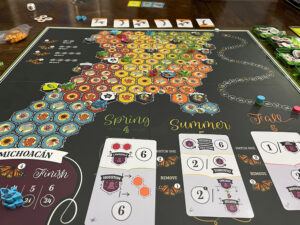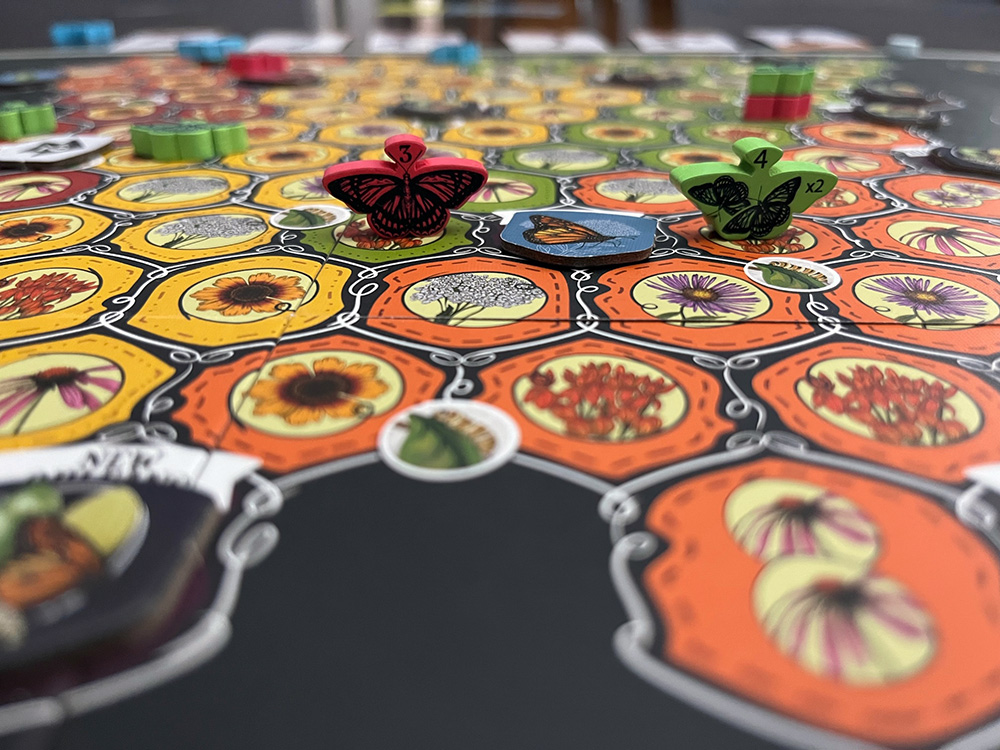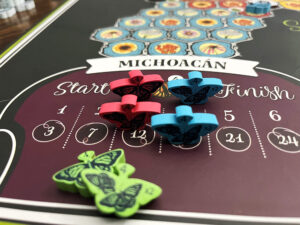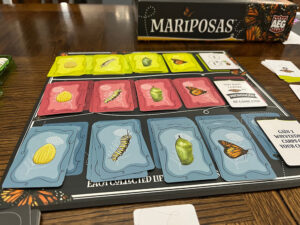 With the migration of the Eastern Monarch Butterfly making news in my house this fall, as it was discussed in both my sons’ third-grade science and seventh-grade geography classes, Mariposas (Spanish for butterfly) seemed like the perfect game to review at this time. Elizabeth Hargrave apparently loves creatures that fly as she has followed up her remarkable debut game Wingspan with Mariposas, a game that covers the entire migration of the Eastern Monarch Butterfly.
With the migration of the Eastern Monarch Butterfly making news in my house this fall, as it was discussed in both my sons’ third-grade science and seventh-grade geography classes, Mariposas (Spanish for butterfly) seemed like the perfect game to review at this time. Elizabeth Hargrave apparently loves creatures that fly as she has followed up her remarkable debut game Wingspan with Mariposas, a game that covers the entire migration of the Eastern Monarch Butterfly.
Mariposas is a game of movement and set collection with baby-making thrown in for fun (as it tends to be) for 2-5 players that takes 45-75 minutes depending on player count and experience with the game. I have played it most often with 3-4 players.
Gameplay Overview:
The game is played over 3 seasons (Spring, Summer, and Fall). Each player has 4 turns to move their butterflies in Spring, 5 turns in Summer, and 6 turns in Fall. Each season has goals that are scored at the end of the season or instantly during the season. Final round scoring has both the Fall goals and scoring based on how many fourth-generation butterflies make the return trip to Michoacán for winter.
The gameplay is relatively straightforward, on your turn you:

Play one movement card and move your butterfly(s) accordingly and collect the flower tokens or waystation tokens depicted on the spaces.
Reproduce if you land on a milkweed symbol and if you have the required flower tokens.
- To make a generation 2 butterfly you need two identical flower tokens or 3 of any flower,
- To make a generation 3 butterfly you need three identical flower tokens or 4 of any flower
- To make a generation 4 butterfly (or 2) you need 4 identical flower tokens or 5 of any flower.
Author’s note: Yes it is weird that you don’t need two butterflies, but I digress.
Draw back up to two cards
If one of your butterflies lands on a city tile you get a waystation token or a bonus move card. If you collect all 5 life cycle waystation tokens of one color you get a valuable bonus, but this is ridiculously hard.
At the end of the season, you score the goals on the season card, if you have not reproduced all of your next-generation butterflies, you now get to have free babies, then kill off your previous-generation butterflies. Circle of life. Then flip over the next season’s goals and restart.

Game Experience:
If you have a group that is focused and doesn’t interrupt the game to ask lots of questions about the birds and the bees, or in this case butterflies and milkweed, this game plays very fast. Turns are simple, play a movement card, collect flower tokens, reproduce or don’t, draw a new card. The end goal of this mostly multiplayer solitaire game is to return as many fourth-generation butterflies back to Michoacán to spend the winter.

The scoring of returned butterflies is quite well thought out one=3 points, two=7, three=12, four=17, five=21, six=24, and any above six scores 2 additional points. This scoring arc makes you participate in the theme of the great migration instead of just making as many babies as close to Mexico as possible. This is because the Season Goals are all related to moving further north and east (as the butterflies do IRL) and will score you more points than the three-point difference from 5 to 6 butterflies and the additional 2 points above 6 butterflies.
This scoring dynamic is what makes the strategy of when and where to reproduce your next-generation butterflies and where to move which butterflies. Mathematically, you want to insure that you can return at least 4 butterflies back to Michoacán to get the maximum benefit of the scoring arc but if you can score fall season goals and return more than four go for it, or if the fall goals earn you more points than returning to Michoacán let you butterflies freeze to death on the east coast, your choice.
This whole strategy is, in my opinion, what makes this game fun and stand out. With only two movement cards in your hand you can only definitively strategize your next move, because you don’t know what your options are for the move after next. So do you prioritize season goals, gaining flower tokens, reproducing as fast as possible, or the return to Michoacán?

Then there are the waystation tokens and cards. The randomness of these tokens makes the set collection nearly impossible in my experience, but each one does give you a point at the end game, so they have value even without completing a set. Also, if you are the first butterfly to land on the waystation you roll a die to determine which flower you get. This randomness can alter your strategy for reproducing. For these reasons, we have found that the risk of going to the waystation tokens is not worth it in many situations.
The main board design is attractive and the black background gives it a monarch butterfly feeling. The tokens and cards are of high quality. The waystation board and cards combination on the other hand are less than ideal. The cards slide all over the board and make it a mess. It’s not that important as it’s just a place to draw cards from, but it’s a bit annoying.
Final Thoughts:
I really enjoy going on this migration journey with my butterflies. We have played at least 10 games of Mariposas and the player count has never affected the enjoyment of the gameplay. The 20-season goal cards offer a good variety of ways to score and increase replay value as we have never had the same three goals in those 10 games. We have had just as many games won by the player with the most fourth-generation butterflies completing the journey back to Michoacán as not, which shows that the scoring is well-balanced for a variety of strategies. My biggest critique of Mariposas is the waystations. Thematically, they are very important as waystations help the survival of the monarch, but we have found that all of the randomness they provide does not help you win the game.
Final Score: 4.5 Stars – Excellent adherence to theme with multiple strategies that can be employed to win this easy-to-learn, fast-to-play movement and set collection game.
 Hits:
Hits:
• It’s fun and fast for ages 8 and up
• It’s equally fun at 2 players and 5 players.
• It is a very well-balanced game that allows you to try different strategies.
• It nails the theme perfectly
• The main board/components/art are well designed
Misses:
• The waystation tokens ought to add an additional strategy to win, but the randomness limits the effectiveness of this strategy
• If playing with children you may end up having the sex talk earlier than you want or if they are shy you just might have them taking milkweed to bed with them.





















